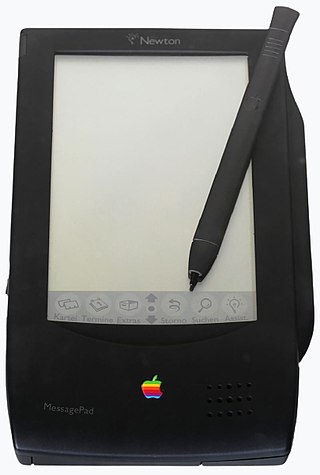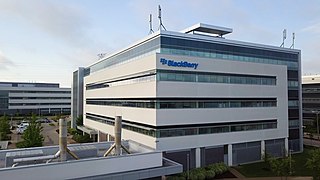
The MessagePad is a discontinued series of personal digital assistant devices developed by Apple Computer for the Newton platform in 1993. Some electronic engineering and the manufacture of Apple's MessagePad devices was undertaken in Japan by Sharp. The devices are based on the ARM 610 RISC processor and all featured handwriting recognition software and were developed and marketed by Apple. The devices run Newton OS.
Speech recognition is an interdisciplinary subfield of computer science and computational linguistics that develops methodologies and technologies that enable the recognition and translation of spoken language into text by computers. It is also known as automatic speech recognition (ASR), computer speech recognition or speech to text (STT). It incorporates knowledge and research in the computer science, linguistics and computer engineering fields. The reverse process is speech synthesis.

Optical character recognition or optical character reader (OCR) is the electronic or mechanical conversion of images of typed, handwritten or printed text into machine-encoded text, whether from a scanned document, a photo of a document, a scene photo or from subtitle text superimposed on an image.

A smartphone is a mobile device that combines the functionality of a traditional mobile phone with advanced computing capabilities. It typically has a touchscreen interface, allowing users to access a wide range of applications and services, such as web browsing, email, social media, and multimedia playback. Smartphones also have built-in cameras, GPS navigation, and support for various communication methods, including voice calls, text messaging, and internet-based messaging apps.

Handwriting recognition (HWR), also known as handwritten text recognition (HTR), is the ability of a computer to receive and interpret intelligible handwritten input from sources such as paper documents, photographs, touch-screens and other devices. The image of the written text may be sensed "off line" from a piece of paper by optical scanning or intelligent word recognition. Alternatively, the movements of the pen tip may be sensed "on line", for example by a pen-based computer screen surface, a generally easier task as there are more clues available. A handwriting recognition system handles formatting, performs correct segmentation into characters, and finds the most possible words.

BlackBerry Limited is a Canadian software company specializing in cybersecurity. Founded in 1984, it originally developed the BlackBerry brand of interactive pagers, smartphones and tablets. In 2016, it transitioned to a cybersecurity enterprise software and services company under CEO John S. Chen. Its products are used by various businesses, car manufacturers, and government agencies to prevent hacking and ransomware attacks. They include the BlackBerry Cylance, the QNX real-time operating system; BlackBerry Enterprise Server, and a Unified Endpoint Management (UEM) platform.

Mobile computing is human–computer interaction in which a computer is expected to be transported during normal usage and allow for transmission of data, which can include voice and video transmissions. Mobile computing involves mobile communication, mobile hardware, and mobile software. Communication issues include ad hoc networks and infrastructure networks as well as communication properties, protocols, data formats, and concrete technologies. Hardware includes mobile devices or device components. Mobile software deals with the characteristics and requirements of mobile applications.

A mobile device, also referred to as a digital assistant, is a computer small enough to hold and operate in the hand. Mobile devices typically have a flat LCD or OLED screen, a touchscreen interface, and digital or physical buttons. They may also have a physical keyboard. Many mobile devices can connect to the Internet and connect with other devices, such as car entertainment systems or headsets, via Wi-Fi, Bluetooth, cellular networks, or near-field communication. Integrated cameras, the ability to place and receive voice and video telephone calls, video games, and Global Positioning System (GPS) capabilities are common. Power is typically provided by a lithium-ion battery. Mobile devices may run mobile operating systems that allow third-party applications to be installed and run.

Motorola A925 is a 3G smartphone from Motorola using Symbian OS. Among the most notable features is its built-in A-GPS. The A925 was preceded by the featurewise essentially identical Motorola A920, and was succeeded by the Motorola A1000.

A tablet computer, commonly shortened to tablet, is a mobile device, typically with a mobile operating system and touchscreen display processing circuitry, and a rechargeable battery in a single, thin and flat package. Tablets, being computers, have similar capabilities, but lack some input/output (I/O) abilities that others have. Modern tablets largely resemble modern smartphones, the only differences being that tablets are relatively larger than smartphones, with screens 7 inches (18 cm) or larger, measured diagonally, and may not support access to a cellular network. Unlike laptops, tablets usually run mobile operating systems, alongside smartphones.

Martin Cooper is an American engineer. He is a pioneer in the wireless communications industry, especially in radio spectrum management, with eleven patents in the field.
The Motorola Q is a Windows Mobile smartphone first announced in the Summer of 2005 as a thin device with similar styling to Motorola's immensely popular RAZR. Motorola in a partnership with Verizon Wireless released the Q on May 31, 2006. A version for Sprint was released early in January 2007 and one for Amp'd Mobile in April 2007.

Richard "Dick" Francis Lyon is an American inventor, scientist, and engineer. He is one of the two people who independently invented the first optical mouse devices in 1980. He has worked in signal processing and was a co-founder of Foveon, Inc., a digital camera and image sensor company.

Paragon Software Group is a German software company that develops hard drive management software, low-level file system drivers and storage technologies. The Smart Handheld Device Division (SHDD) offers multilingual dictionaries, multilingual handwriting recognition, weather information, and two-way data synchronization with desktop devices.
The IET Mountbatten Medal is awarded annually for an outstanding contribution, or contributions over a period, to the promotion of electronics or information technology and their application. The Medal was established by the National Electronics Council in 1992 and named after Louis Mountbatten, The Earl Mountbatten of Burma, Admiral of the Fleet and Governor-General of India. Since 2011, the medal has been awarded as one of the IET Achievement Medals.
Vlingo was a speech recognition software company co-founded by speech-to-text pioneers Mike Phillips and John Nguyen in 2006. It was best known for its intelligent personal assistant and knowledge navigator, also named Vlingo, which functioned as a personal assistant application for Symbian, Android, iPhone, BlackBerry, and other smartphones. Vlingo was acquired by speech recognition giant Nuance Communications in 2012.
Nelson Harold Morgan is an American computer scientist and professor in residence (emeritus) of electrical engineering and computer science at the University of California, Berkeley. Morgan is the co-inventor of the Relative Spectral (RASTA) approach to speech signal processing, first described in a technical report published in 1991.

Good Technology, owned by BlackBerry Limited, is a mobile security provider headquartered in Sunnyvale, California, United States. The company serves more than 5,000 organizations worldwide in industries such as financial services, healthcare, manufacturing, energy and utilities, legal, government, and technology. Good makes products for managing and securing mobile devices in a business environment. The company focuses on securing apps and data on mobile devices.
Alex Graves is a computer scientist. Before working as a research scientist at DeepMind, he earned a BSc in Theoretical Physics from the University of Edinburgh and a PhD in artificial intelligence under Jürgen Schmidhuber at IDSIA. He was also a postdoc under Schmidhuber at the Technical University of Munich and under Geoffrey Hinton at the University of Toronto.

Stephen John Young is a British researcher, Professor of Information Engineering at the University of Cambridge and an entrepreneur. He is one of the pioneers of automated speech recognition and statistical spoken dialogue systems. He served as the Senior Pro-Vice-Chancellor of the University of Cambridge from 2009 to 2015, responsible for planning and resources. From 2015 to 2019, he held a joint appointment between his professorship at Cambridge and Apple, where he was a senior member of the Siri development team.